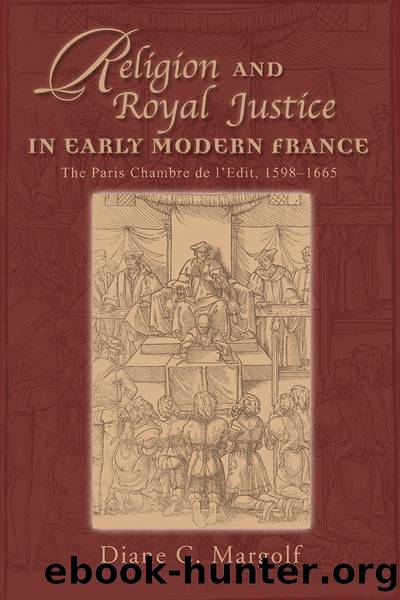Religion and Royal Justice in Early Modern France by Diane C. Margolf;

Author:Diane C. Margolf; [Margolf, Diane C.]
Language: eng
Format: epub
Tags: HIS013000 History / Europe / France
ISBN: 9781935503668
Publisher: PennStateUP
Published: 2017-04-12T05:00:00+00:00
Rutvelt and Andrix had denounced Vescure to a local magistrate, claiming that he had gotten Rutvelt pregnant. With the help of two huissiers (who threatened to kill him if he resisted), they forced Vescure to sign several documents that he allegedly did not understand because of his youth and his unfamiliarity with the French language. Vescure portrayed both women as âdisreputable persons of no consequence who barely gain their living by selling beer and housing the captains of foreign ships,â describing Rutvelt as a prostitute who had seduced several other young men.65 In this case, however, the Chambre de lâEdit rejected the story of scheming women who had brought about a young manâs downfall with a secret, unsuitable [120] marriage. The magistrates sentenced Vescure to pay Rutvelt 3000 livres to help her marry, 2700 livres to support her child, and another 400 livres in alms.66
Cases of rapt and clandestine marriage illustrate the Chambre de lâEditâs efforts to enforce royal ordinances that prohibited such unions, as well as to remedy the social disorders associated with illicit marriages. Accusations of rapt might reveal connivance and subornation of minors; on the other hand, spouses or their relatives might use such charges to attack a valid marriage. When adjudicating this kind of family dispute, the chamber magistrates acted to abolish illegal unions and punish the parties involved, but they also sought to protect those who had not broken the law. In doing so, the court not only enforced the relevant laws, but also acknowledged a âpublic interestâ in preserving social and familial order.
The Chambre de lâEdit occasionally received requests to dissolve marriages without reference to the crimes of rapt or clandestine marriage. The magistrates could not pronounce on the sacramental or spiritual aspect of a union, but they could invalidate its civil effects. In 1648, damoiselle Marie dâHertoghe dâOrsmael requested that the court dissolve her marriage to Hermant de Riperda, which had taken place a year earlier, by declaring it to be ânull and invalidly contractedâ [nul et non valablement contracté]. After questioning Marie and hearing the royal prosecutorâs comments, the court granted her petition. Riperda was forbidden âto call himself her husband in future nor to attack her person and goodsâ and was condemned to costs and damages.67
The Chambre de lâEdit received a unique request to dissolve a marriage in November 1602, when Marthe Ranart appealed to have her union with Claude Pallier, sieur de Nitras, abolished on the grounds of impotence. Both canon law and Reformed disciplines recognized impotence as grounds for invalidating a marriage, but judges sometimes invoked an unusual mode of proof in such cases: the essai de congrès, in which a husband demonstrated his sexual capacity with his wife in the presence of witnesses.68 The seneschal of Angoulême had ordered Pallier and [121] Ranart to undergo this procedure in 1601, a decision which the Chambre de lâEdit confirmed a year later. Pallier refused to comply, however, and demanded a final judgment of the case. He and Ranart were summoned
Download
This site does not store any files on its server. We only index and link to content provided by other sites. Please contact the content providers to delete copyright contents if any and email us, we'll remove relevant links or contents immediately.
| Belgium | France |
| Germany | Great Britain |
| Greenland | Italy |
| Netherlands | Romania |
| Scandinavia |
Room 212 by Kate Stewart(4720)
The Crown by Robert Lacey(4560)
Endurance: Shackleton's Incredible Voyage by Alfred Lansing(4478)
The Iron Duke by The Iron Duke(4101)
The Rape of Nanking by Iris Chang(4005)
Killing England by Bill O'Reilly(3892)
Joan of Arc by Mary Gordon(3769)
Say Nothing by Patrick Radden Keefe(3707)
I'll Give You the Sun by Jandy Nelson(3256)
Shadow of Night by Deborah Harkness(3163)
Hitler's Monsters by Eric Kurlander(3146)
Blood and Sand by Alex Von Tunzelmann(3045)
Mary, Queen of Scots, and the Murder of Lord Darnley by Alison Weir(3041)
Darkest Hour by Anthony McCarten(3010)
Margaret Thatcher: The Autobiography by Thatcher Margaret(2964)
Eleanor & Park by Rainbow Rowell(2928)
Red Famine: Stalin's War on Ukraine by Anne Applebaum(2806)
Book of Life by Deborah Harkness(2707)
The One Memory of Flora Banks by Emily Barr(2675)
